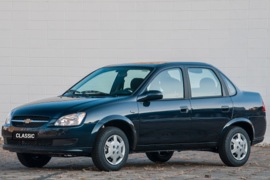CHEVROLET Classic Models/Series Timeline, Specifications & Photos
First production year: 2002
Engines: Ethanol, Gasoline
Due to the high demand for sedans in the South American market, in 2002, Chevrolet introduced a three-box bodywork version for the already known Corsa in Brazil.
While the Corsa was mainly developed for the European market, the South American customers also got their hand on it, albeit it was badged as a Chevrolet instead of an Opel or Vauxhall. The car was well-received, but from the customers' points of view, it lacked a very important element: a proper trunk. But GM had a solution for that, so, in 2002, it came with the Chevrolet Classic: a three-box Corsa.
From the front, it was the same mundane Corsa, with its headlights that combined in a triangular shape with curved lines and sharp angles. The most significant difference was in its profile. While the vehicle was similar to the five-door Corsa up to the D-pillar, including a third side window behind the rear doors, the back was completely different. The rear windscreen was raked-forward, not vertical like on the rest of the Corsa range. Moreover, a regular trunk replaced the hatchback-style rear end. That led to the introduction of a new set of corner-mounted taillights, extended from the quarter-panels to the trunk's lid.
Inside, the dashboard and the front seats were exactly the same as on the rest of the Corsa's lineup. Depending on the trim level, it sported cranked or power windows. Strangely though, the door mirrors were manual, even on the better-optioned versions. At the back, the split-folding bench was replaced by a fixed one, so the passengers couldn't feel like they shared the same area with the luggage.
Under the hood, Chevrolet used a few inline-four engines paired as standard with a five-speed manual. For selected versions, though, it added a four-speed automatic.
